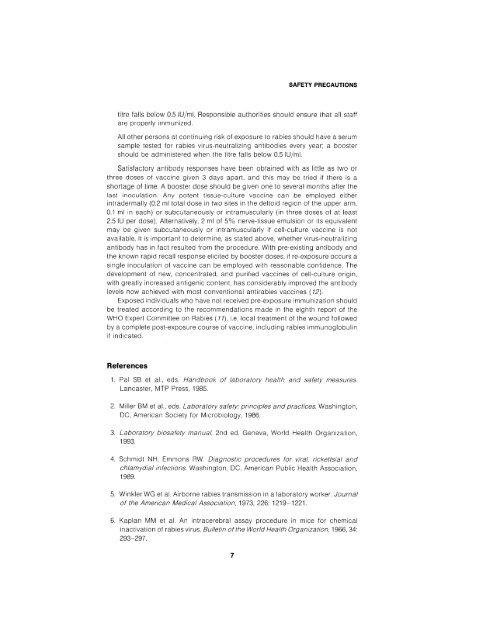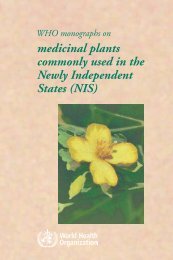in rabies - libdoc.who.int - World Health Organization
in rabies - libdoc.who.int - World Health Organization
in rabies - libdoc.who.int - World Health Organization
You also want an ePaper? Increase the reach of your titles
YUMPU automatically turns print PDFs into web optimized ePapers that Google loves.
SAFETY PRECAUTIONS<br />
titre falls below 0.5 IU/ml. Responsible authorities should ensure that all staff<br />
are properly immunized.<br />
All other persons at cont<strong>in</strong>u<strong>in</strong>g risk of exposure to <strong>rabies</strong> should have a serum<br />
sample tested for I-abies virus-neutraliz<strong>in</strong>g antibodies every year; a booster<br />
should be adm<strong>in</strong>istered when the titre falls below 0.5 U/ml.<br />
Satisfactory antibody responses have been obta<strong>in</strong>ed with as little as two or<br />
three doses of vacc<strong>in</strong>e given 3 days apart, and this may be tried if there is a<br />
shortage of time. A booster dose should be given one to several montiis after the<br />
last <strong>in</strong>oculation. Any potent tissue-cultiire vacc<strong>in</strong>e can be employed either<br />
<strong>in</strong>tradermally (0.2 m1 total dose <strong>in</strong> two sites <strong>in</strong> the deltoid reglon of the upper arm,<br />
0.1 ml <strong>in</strong> each) or subcutaneously or <strong>in</strong>tramuscularly (<strong>in</strong> three doses of at least<br />
2.5 IU per dose). Alternatively, 2 ml of 5% nerve-tissue emulsion or its equivalent<br />
may be given subcutaneously or <strong>in</strong>tramuscularly if cell-culture vacc<strong>in</strong>e is not<br />
available. It is important to determ<strong>in</strong>e, as stated above, whether virus-neutraliz<strong>in</strong>g<br />
antibody has <strong>in</strong> fact resulted from the procedure. With pre-exist<strong>in</strong>g antibody and<br />
the known rapid recall response elicited by booster doses, if re-exposure occurs a<br />
s<strong>in</strong>gle <strong>in</strong>oculation of vacc<strong>in</strong>e can be employed with reasonable confidence. The<br />
development of new, concentrated, and purified vacc<strong>in</strong>es of cell-culture orig<strong>in</strong>,<br />
with greatly <strong>in</strong>creased antgenic content, has considerably improved the antibody<br />
levels now achieved with most conventional anti<strong>rabies</strong> vacc<strong>in</strong>es (12).<br />
Exposed <strong>in</strong>dividuals <strong>who</strong> have not received pre-exposure immunization should<br />
be treated accord<strong>in</strong>g to the recommendations made <strong>in</strong> the eighth report of the<br />
WHO Expert Committee on Rabies (11). i.e. local treatment of the wound followed<br />
by a complete post-exposure course of vacc<strong>in</strong>e, <strong>in</strong>clud<strong>in</strong>g <strong>rabies</strong> immunoglobul<strong>in</strong><br />
if <strong>in</strong>dicated.<br />
References<br />
1. Pal SB et al, eds. Handbook of laboratory health and safety measures<br />
Lancaster, MTP Press. 1985.<br />
2. Miller BM et al , eds. Laboratory safety: pr<strong>in</strong>ciples and practices. Wash<strong>in</strong>gton,<br />
DC, American Society for Microbiology, 1986.<br />
3, Laboratory biosafety manual. 2nd ed. Geneva, <strong>World</strong> <strong>Health</strong> <strong>Organization</strong>,<br />
1993.<br />
4. Schmidt NH, Emmons RW. Diagnostic procedures for viral, rickettsia1 and<br />
chlamydial <strong>in</strong>fections. Wash<strong>in</strong>gton. DC, American Public <strong>Health</strong> Association.<br />
1989.<br />
5. W<strong>in</strong>kler WG et al. Airborne <strong>rabies</strong> trans<strong>in</strong>isson <strong>in</strong> a laboratory worker Journal<br />
of the American Medical Association, 1973, 226: 1219-1 221<br />
6 Kaplan MM et al. An <strong>in</strong>tracerebral assay procedure <strong>in</strong> mice for chemical<br />
<strong>in</strong>activation of <strong>rabies</strong> virus. Bullet<strong>in</strong> of the <strong>World</strong> <strong>Health</strong> <strong>Organization</strong>, 1966, 34:<br />
293- 297.
















